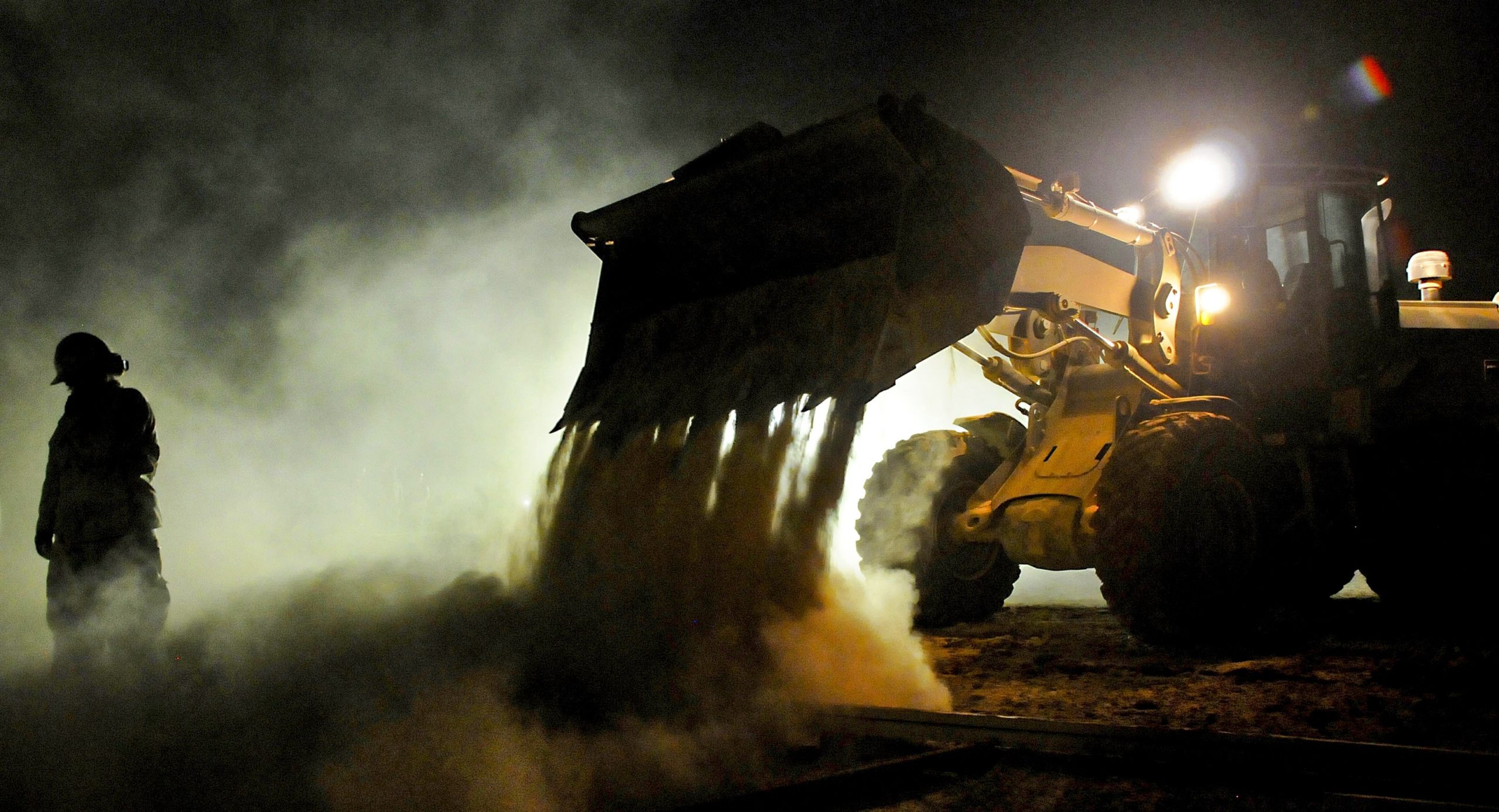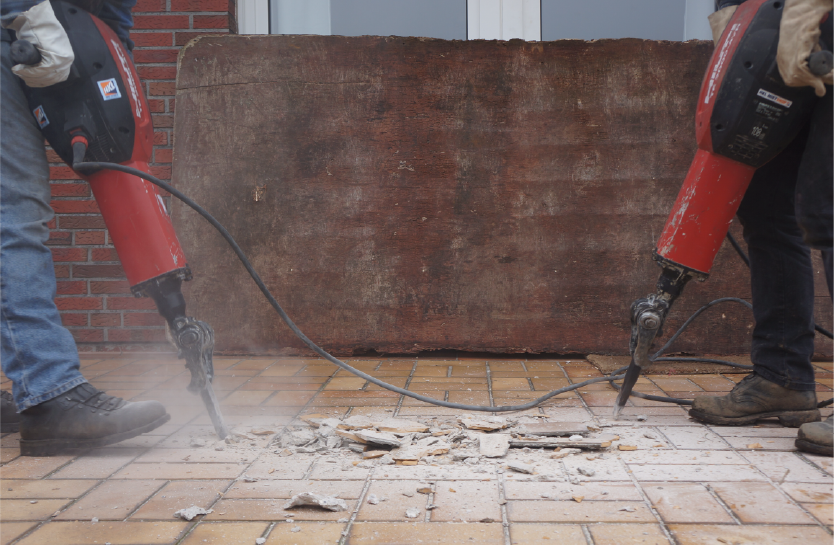Silicosis
Background
Silicosis is scarring and thickening of the lungs caused by inhalation of silica dust. Silicosis reduces lung capacity and can cause symptoms such as chronic cough, shortness of breath, and fatigue. It is a rare disease that develops decades after exposure to silica dust.
Risk factors
-
- Crystalline silica dust, including quartz and cristobalite [1]
Workers in construction, mining, and some manufacturing industries are at an increased risk for developing silicosis due to occupational silica exposure. Silica is found naturally occurring in rocks, soil, and sand and is also found in construction materials including concrete and brick. Tasks such as drilling or grinding concrete, sandblasting, and stonecutting can lead to high levels of silica exposure.
Key Findings
The greatest risks of silicosis were observed among workers employed in the mining and primary metal processing sectors. Increased risk of silicosis was also observed among construction industry workers.
Mining
 Workers in mining and quarrying occupations may be exposed to silica during processes such as drilling, crushing, or blasting rock and stone.
Workers in mining and quarrying occupations may be exposed to silica during processes such as drilling, crushing, or blasting rock and stone.
-
- Mining and quarrying including oil and gas occupations: 18.6 times the risk
- Rock and soil-drilling occupations: 19.7 times the risk
- Mining and quarrying: cutting, handling and loading occupations: 16.5 times the risk
- Mining and quarrying including oil and gas occupations: 18.6 times the risk
Primary metal industries
 Workers in iron and steel foundries are exposed to silica dust contained in foundry sand [2].
Workers in iron and steel foundries are exposed to silica dust contained in foundry sand [2].
-
- Iron foundries: 9.72 times the risk
- Iron and steel mills: 1.40 times the risk
Metal processing and metal working occupations
 Metal processing occupations involve operating furnaces, metal smelting, moulding, casting, rolling, and extruding, and related activities. Foundry workers have known exposure to silica in foundry sand. Metal workers are involved in metal shaping and forming, including forging, welding and flame cutting which can release silica into the work environment [3].
Metal processing occupations involve operating furnaces, metal smelting, moulding, casting, rolling, and extruding, and related activities. Foundry workers have known exposure to silica in foundry sand. Metal workers are involved in metal shaping and forming, including forging, welding and flame cutting which can release silica into the work environment [3].
-
- Metal processing and related occupations: 2.45 times the risk
- Metal shaping and forming occupations: 1.41 times the risk
- Metalworking-machine operators: 1.69 times the risk
- Welding and flame cutting occupations: 1.26 times the risk
Construction
 Workers can be exposed to silica dust during construction processes such as sandblasting, and breaking, grinding, cutting, drilling or sawing silica-containing materials including concrete, brick and mortar [4].
Workers can be exposed to silica dust during construction processes such as sandblasting, and breaking, grinding, cutting, drilling or sawing silica-containing materials including concrete, brick and mortar [4].
-
- Construction industry overall: 1.20 times the risk
- General contractors: 1.27 times the risk
- Building construction: 1.48 times the risk
- Special-trade contractors: 1.14 times the risk
- General contractors: 1.27 times the risk
- Construction industry overall: 1.20 times the risk
Relative Risk by Industry and Occupation
Figure 1. Risk of silicosis diagnosis among workers employed in each industry group relative to all others, Occupational Disease Surveillance System (ODSS), 1999-2016

The hazard ratio is an estimate of the average time to diagnosis among workers in each industry/occupation group divided by that in all others during the study period. Hazard ratios above 1.00 indicate a greater risk of disease in a given group compared to all others. Estimates are adjusted for birth year and sex. The width of the 95% Confidence Interval (CI) is based on the number of cases in each group (more cases narrows the interval).
Figure 2. Risk of silicosis diagnosis among workers employed in each occupation group relative to all others, Occupational Disease Surveillance System (ODSS), 1999-2016

The hazard ratio is an estimate of the average time to diagnosis among workers in each industry/occupation group divided by that in all others during the study period. Hazard ratios above 1.00 indicate a greater risk of disease in a given group compared to all others. Estimates are adjusted for birth year and sex. The width of the 95% Confidence Interval (CI) is based on the number of cases in each group (more cases narrows the interval).
Table of Results
Table 1. Surveillance of Silicosis: Number of cases, workers employed, and hazard ratios in each industry (SIC)
| SIC Code * | Industry Group | Number of cases | Number of workers employed | Hazard Ratio (95% CI) † |
| 1 | Agriculture | <5 | 27,816 | — |
| 2/3 | Forestry, Fishing and Trapping |
0 | 7,857 | — |
| 4 | Mines, Quarries and Oil Wells |
27 | 18,186 | 10.60 (6.98-16.10) |
| 5 | Manufacturing | 74 | 565,737 | 1.13 (0.84-1.51) |
| 6 | Construction | 22 | 175,679 | 1.20 (0.77-1.89) |
| 7 | Transportation, Communication and Other Utilities |
7 | 165,949 | 0.36 (0.17-0.77) |
| 8 | Trade | 18 | 357,388 | 0.55 (0.34-0.90) |
| 9 | Finance, Insurance and Real Estate |
<5 | 19,415 | — |
| 10 | Community, Business and Personal Service |
37 | 484,003 | 0.85 (0.58-1.25) |
| 11 | Public Administration and Defense |
12 | 157,933 | 0.63 (0.35-1.12) |
| * SIC: Standard Industrial Classification (1970) | ||||
| † Hazard rate in each group relative to all others | ||||
Table 2. Surveillance of Silicosis: Number of cases, workers employed, and hazard ratios in each occupation (CCDO) group
| CCDO Code * | Occupation Group | Number of cases | Number of workers employed | Hazard Ratio (95% CI) † |
| 11 | Managerial, administrative and related |
<5 | 26,772 | — |
| 21 | Natural sciences, engineering and mathematics |
<5 | 22,792 | — |
| 23 | Social sciences and related fields |
<5 | 24,940 | — |
| 25 | Religion | 0 | 113 | — |
| 27 | Teaching and related | <5 | 41,694 | — |
| 31 | Medicine and health | 12 | 108,760 | 1.46 (0.78-2.73) |
| 33 | Artistic, literary, recreational and related |
0 | 12,730 | — |
| 41 | Clerical and related | 9 | 162,138 | 0.57 (0.29-1.13) |
| 51 | Sales | 6 | 123,290 | 0.66 (0.29-1.50) |
| 61 | Service | 31 | 298,291 | 1.08 (0.73-1.59) |
| 71 | Farming, horticultural and animal husbandry |
<5 | 40,975 | — |
| 73 | Fishing, hunting, trapping and related |
0 | 463 | — |
| 75 | Forestry and logging | 0 | 7,729 | — |
| 77 | Mining and quarrying, including oil and gas field |
25 | 10,051 | 18.60 (12.00-28.60) |
| 81 | Processing (mineral, metal, chemical) |
15 | 67,243 | 2.26 (1.33-3.84) |
| 82 | Processing (food, wood, textile) |
8 | 81,535 | 1.01 (0.49-2.04) |
| 83 | Machining and related | 25 | 161,901 | 1.34 (0.87-2.05) |
| 85 | Product fabricating, assembling and repairing |
31 | 276,757 | 0.93 (0.63-1.38) |
| 87 | Construction trades | 19 | 181,408 | 0.84 (0.52-1.36) |
| 91 | Transport equipment operating |
6 | 143,841 | 0.34 (0.15-0.77) |
| 93 | Materials handling and related, not elsewhere classified |
10 | 128,518 | 0.78 (0.41-1.48) |
| 95 | Other crafts and equipment operating |
<5 | 23,409 | — |
| 99 | Other occupations not elsewhere classified | 15 | 180,651 | 0.83 (0.49-1.41) |
| * CCDO: Canadian Classification Dictionary of Occupations (1971) | ||||
| † Hazard rate in each group relative to all others | ||||
Please note that ODSS results shown here may differ from those previously published or presented. This may occur due to changes in case definitions, methodological approaches, and the ongoing nature of the surveillance cohort.
References
- Leung CC, Yu ITS, Chen W. Silicosis. Lancet. 2012;379:2008–18.
- Morteza MM, Hossein K, Amirhossein M, Naser H, Gholamhossein H, Hossein F. Designing, construction, assessment, and efficiency of local exhaust ventilation in controlling crystalline silica dust and particles, and formaldehyde in a foundry industry plant. Arh Hig Rada Toksikol. 2013;64(1):123–31.
- Canadian Centre for Occupational Health and Safety. Welding – Fumes And Gases: OSH Answers. (Updated 2016).
- US Occupational Safety and Health Administration. Metalworking Fluids: Safety and Health Best Practices Manual.
